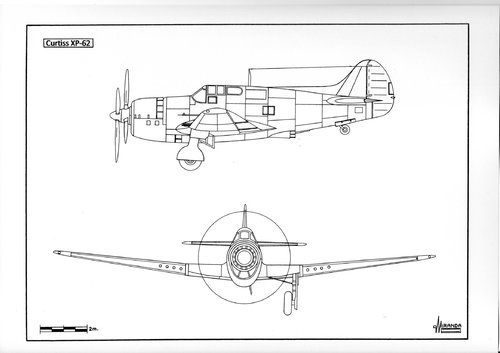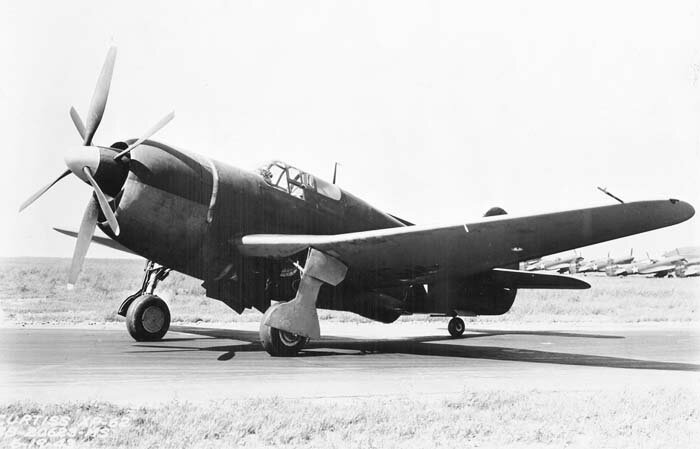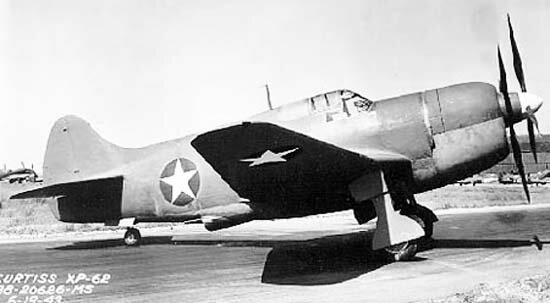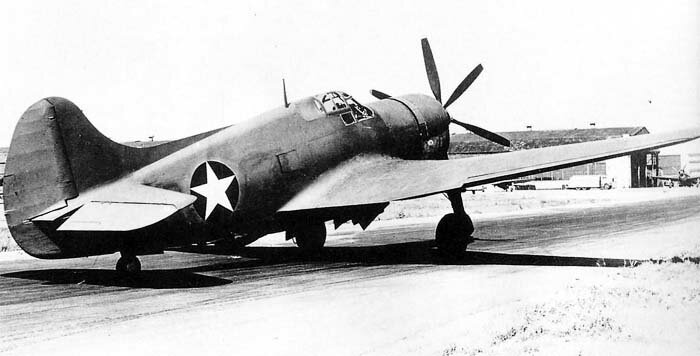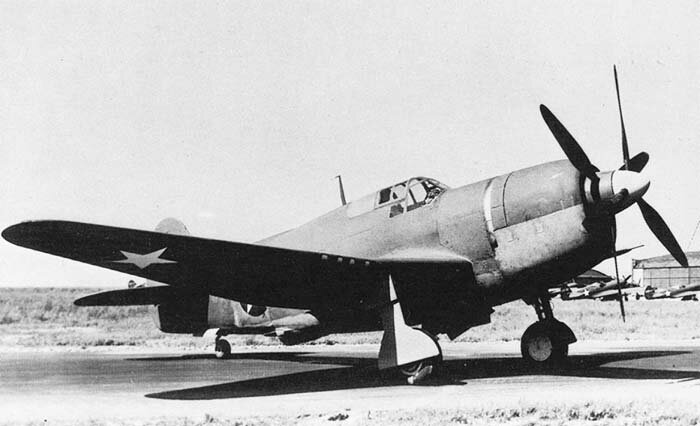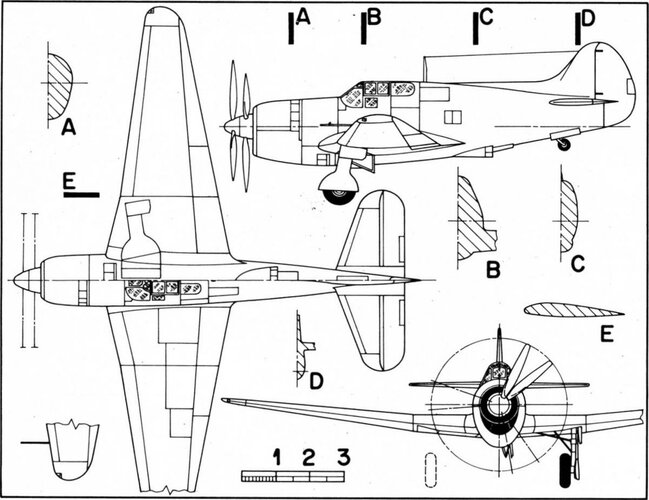Experimental fighter Curtiss XP-62
The contribution of the famous American aircraft manufacturer Curtiss-Wright (Curtiss) to the victory of the Allies in World War II is beyond doubt. If we leave aside the Hawk 75 (P-36) fighters, which were obsolete at the beginning of the war, then 13,738 P-40 family fighters, 7,200 SB2C Helldiver carrier-based dive bombers and 3,183 C-46 Commando military transport aircraft built at factories in Buffalo, St. Louis and Louisville (including the SB2C built in Canada) speak for themselves.
Despite these great achievements, the company's R&D policy was in an unfavorable situation, and the intervention of the Air Arm Command dealt a severe blow to Curtiss's plans. Particularly in the area of modern fighter aircraft, Curtiss was never able to restore its reputation as the largest supplier to the U.S. Army Air Forces. This led not only to financial losses, but also to reputational losses. From 1940 until the end of 1941, when the United States entered World War II, Curtiss struggled to develop a worthy replacement for the P-40 fighter, which was increasingly lagging behind the needs of the front in Europe and Africa.
The new prototype, designated P-60, approached the Thunderbolt in performance, but the United States' entry into the war required urgent mass production of the aircraft already in service, and the program was cancelled in January 1942. To avoid interruptions in P-40 production, the Army Air Forces ordered Curtiss to begin production of improved versions of the P-40K and P-40L. In addition, the Buffalo plant was ordered to build 354 Republic P-47G-CU Thunderbolt fighters under license; this order was completed during 1942.
In January 1941, Curtiss received a proposal to develop a high-altitude fighter with a pressurized cabin, an 18-cylinder Wright R-3350 engine, armament of eight 20-mm cannon or twelve 12.7-mm machine guns, and a maximum speed of 450 mph (753 km/h) at 27,500 ft (8,200 m). The requirements were too high, but Curtiss took on the job and submitted its design in April, after consideration, it was ordered two XP-62 prototypes and a pre-production XP-62A.
In August, the conditions were somewhat relaxed: the maximum speed was reduced to 720 km/h, and the armament remained only in the form of eight 20 mm cannons. Based on the results of the design work, a wooden model was created; in December, it was inspected by a commission, which made about 90 comments. The final decision, made in January 1942, stated that it was necessary to reduce the weight of the glider from 7,070 to 6,360 kg, the armament to four cannons, and install three-bladed coaxial contra-rotating propellers.
On January 13, 1942, the US Army Air Forces placed an order for 100 production P-62A fighters. The first batch was to be delivered in May 1943, and production volumes were to increase in the fall of that year. On May 20 (according to other sources, May 25), 1942, the production order was confirmed, but on July 18 (according to other sources, July 27), the US Army Air Forces cancelled the order (the construction of the second prototype and pre-production P-62A were also cancelled). The reasons for the refusal were the urgent order issued to Curtiss for the production of P-47G heavy escort fighters and the lack of urgent need for specialized high-altitude interceptors.
By this time, the XP-62 prototype was 80% complete and work continued on it, with the first flight expected in April 1943. The XP-62 high-altitude fighter prototype was a robust machine, powered by a Wright R-3350-17 Duplex Cyclone (or Cyclone 18) radial, 18-cylinder air-cooled engine producing 2,300 hp (1,690 kW) and driving coaxial, three-bladed contra-rotating propellers. The engine's exhaust gases were fed to a turbocharger, which, like the Thunderbolt, was located in the lower fuselage between the wing and the tail. However, the Wright R-3350-17 engine was still crude and unfinished, and the pressurized cabin, a first for such a small combat aircraft, created far more problems than initially expected.
Due to problems, the first flight of the XP-62 prototype did not take place until July 21, 1943, a year after the original target date (in April 1941, the prototype was scheduled to be delivered in fifteen months). The XP-62 prototype test flights were conducted without a pressurized cabin, which was not yet ready.
Since, as already mentioned above, in addition to the cancellation of the order for serial production, the construction of the pre-series fighter and the second prototype was cancelled, only one XP-62 prototype was tested. Due to the low priority of the program, the testing of the machine was significantly extended in time.
In February 1944, a decision was made to install a pressurized cabin on the prototype, which was planned to be used for testing and accumulation of practical experience. Work and testing continued until the fall of 1944, when funding for the program was stopped. Curtiss did not want to continue the work at its own expense, and the XP-62 - one of the most massive single-engine aircraft of that time - was sent to be scrapped.
Finally, it should also be said that in addition to the problems listed above, another reason that led to the closure of the P-62 program was the priority in the allocation of Wright R-3350 engines in favor of a more important program: the B-29 heavy long-range bombers.
FLIGHT PERFORMANCE CHARACTERISTICS
Purpose: high-altitude fighter-interceptor
Status: experienced
Manufacturer: Curtiss-Wright Corporation, Aircraft Division, Buffalo, New York
Crew: 1 person.
Powerplant: Wright R-3350-17 Duplex Cyclone (or Cyclone 18), radial, twin-row, 18-cylinder, air-cooled engine, developing 2,300 hp (1,690 kW) and driving coaxial, three-bladed, contra-rotating propellers
Dimensions:
wingspan 16.36 m
length 12.05 m
height 5.00 m
wing area 39.10 m²
Weight:
empty 5345 kg
normal takeoff 6660 kg
takeoff with overload 7560 kg
Flight characteristics:
maximum speed
• at an altitude of 8,230 m – 720 km/h
• at an altitude of 1,525 m – 576 km/h
time to climb to 4,575 m – 6.9 min
service ceiling 10,900 m
flight range from 1,500 to 2,410 km
Armament: four 20 mm cannons
Number of produced: 1 copy.
Опытный истребитель Curtiss XP-62. США - Альтернативная История

alternathistory.ru

